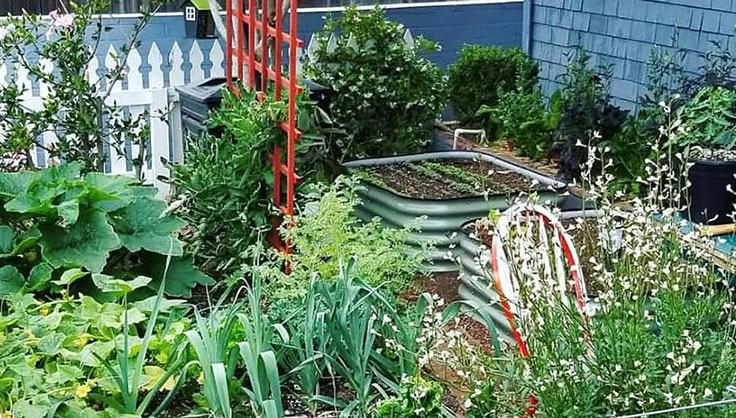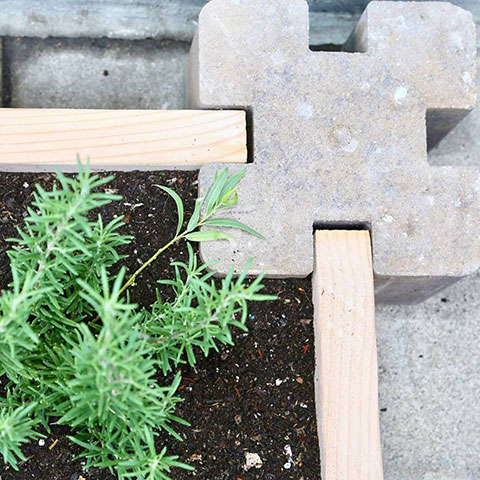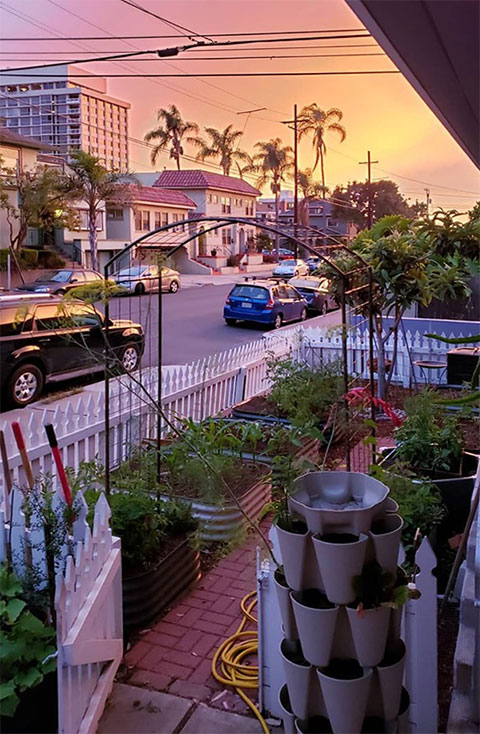What Is An Urban Gardener
More Articles
Find more garden information
Other Article Categories
Urban Gardening Techniques
How to make the most of your growing space
In just nine years, Kevin Espiritu has gone from an absolute beginner gardener, trying his hand at cucumbers and basil, to a top online voice on growing everything from houseplants to edibles. Kevin uses his limited gardening space to experiment with plants and techniques, and his online education platform, epicgardening.com, inspires gardeners around the world. Kevin is also the the author of Field Guide to Urban Gardening: How to Grow Plants, No Matter Where You Live. Learn more about Kevin.
 Kevin's yard is a small oasis that is packed with plants. Photos: Kevin Espiritu
Kevin's yard is a small oasis that is packed with plants. Photos: Kevin Espiritu
Modern society has given us many things, but it has not given many of us sprawling, rural homesteads. Most of us live in tightly-packed urban environments with no space to grow anything... or so we think!
I was of this mindset when I first started gardening. In fact, the first plants I ever grew were bush cucumbers grown in a hydroponic system, because I thought I had no access to light in my small townhouse. Oh, how wrong I was.
If you're living in an apartment with a little balcony, a townhouse, or even a smaller single family home, there are plenty of ways to grow some of your own food. All you have to do is adjust your gardening strategy based on the unique growing environment you're in, which is exactly what we're about to discuss.
Adjust your gardening strategy based on the unique growing environment you're in.
Survey Your Space
No two living spaces are created equal, thus no two growing spaces are either. Look at your space through the lens of a plant:
How much access do you have to light, and what direction is it coming from?
South-facing balconies, windowsills, or front yards are the best if you're in the Northern Hemisphere, as your plants will enjoy full sun all day long. All is not lost if you don't have south-facing access to light, though. There are plenty of shade-tolerant edibles you can still grow.
Also be sure to take note of any trees, buildings, or structures that block light throughout the day. I encourage you observe how light and shadows fall on your property over the course of a day to gain a deeper understanding of your landscape. On top of that, look for any "hot spots," which are areas where reflections from nearby buildings redirect an unnatural amount of light.
Select Your Growing Method
There are five methods I recommend for most urban growing spaces. After you've surveyed your space and determined your access to sun, square footage, and suitable growing conditions, it's up to you to select the method you feel fits your urban space best. Here are a few of my tried-and-true ways to make the most of each growing method in my urban home.
-
Raised Beds
If you're fortunate enough to have enough space to plop down even a 2' x 4' raised bed, you're in business! Make sure it's at least 6" tall, and made from untreated wood. In order of longevity, I prefer redwood to cedar to any other wood. Of course, the longer-lasting wood tends to be a bit pricier.
 One of my favorite ways to create a dirt-cheap raised bed is using 2x6s and "planter blocks."
One of my favorite ways to create a dirt-cheap raised bed is using 2x6s and "planter blocks."You can also opt for a pre-made kit, which is great if you're looking to simplify the building process, and there are plenty of aesthetic options that also have some practical benefits, like being raised to a standing height. I personally love gardening in ultra-tall raised beds. Being 6'4" tall, I want to save my back as I age!
-
Containers
An almost endless variety of containers exist for you to grow in, all depending on what plants you want to grow, your aesthetic tastes, and your space. As far as container materials, each material has its own pros and cons:
Terra cotta. Cheap and effective, but brittle and loses water faster than other materials.
Wood. Easy to DIY, but will rot and fade over time.
Plastic. Durable, but needs drainage and eventually becomes brittle due to UV exposure.
 Growing potatoes in grow bags was a huge success for me this growing season.
Growing potatoes in grow bags was a huge success for me this growing season.I personally grow in terra cotta pots and a "secret weapon" that I've been loving this year... the grow bag. They're portable, foldable, lightweight bags you can move around with ease. Their porosity means I'm not waterlogging any of my container plants, which is a common mistake! I'm growing in roughly 150 sq.ft. of growing space, meaning I'm moving plants around all of the time trying to squeeze in as much as I can, so grabbing a few grow bags by their handles and shuffling them around is a common occurrence in my garden.
-
Vertical Gardening
 The Jardin Rose Arch makes a stunning entryway to my little urban garden.
The Jardin Rose Arch makes a stunning entryway to my little urban garden.Again, in urban spaces, it's all about using every single inch available to you as a grower. One of the easiest ways to make more use of vertical space is to use hanging baskets and either grow trailing edibles like strawberries, or grow vining plants downwards like peas, tomatoes, etc. It sounds weird... but it works! You just need to make sure your hanging basket can support the weight of a fully-loaded tomato plant.
Right now, I'm using the Gardener's Supply Company Jardin Rose Arch to "connect" two of my raised beds. I've got a luffa gourd climbing up one side, and a couple of indeterminate cherry tomatoes climbing up the other. I'm quite excited for the day these two plants "meet" each other!
-
Indoors
 One of the first plants I ever grew commercially were microgreens on my little townhouse balcony.
One of the first plants I ever grew commercially were microgreens on my little townhouse balcony.If you're truly strapped for space and don't have many favorable outdoor locations, growing indoors is a perfect option... and don't think you're limited to only houseplants! The three categories of edibles I recommend for indoor gardening are:
Herbs. Perfect for the sunniest windowsill in your home with a long, rectangular planter.
Sprouts. You don't even need light for these, as you're eating them a day or two after the seeds germinate.
Microgreens. My personal favorite, you can grow miniature nutrient-rich versions of your favorite veggies in a 10x20" propagation tray. -
Balconies and Rooftops
The final method we're covering is more of a locale... two spaces in urban environments that are often forgotten as potential green spaces.
The challenges of balconies and rooftops are the same as any other space, but scaled up due to how high up they are: high wind, intense sun, and water access. I highly encourage you to take extra care when surveying your balcony or rooftop. Pay extra close attention to how the sun travels over the course of a day, making note of hotspots from nearby buildings, or the ground itself. On top of that, the wind is amplified the higher up you grow. Make sure you've secured your containers well, no matter what you choose.
You also need to solve the problem of getting water to your space. I usually opt for a larger-volume watering can with a long spout, so I can get my watering task done in one fill-up and reach the nooks and crannies in my tight growing space.
I hope this overview has opened your eyes to just a few of the possibilities when growing in urban spaces. This is just a primer — let your imagination take you for a ride, mix and match these methods to fit your urban space perfectly, and cultivate that green thumb.
Last updated: 02/17/2021
People who read this article often purchase
Get the Dirt
Stay up to date on new articles and advice. Please fill out the information below.
What Is An Urban Gardener
Source: https://www.gardeners.com/how-to/urban-gardening-techniques/9341.html
Posted by: youngwermell.blogspot.com

0 Response to "What Is An Urban Gardener"
Post a Comment